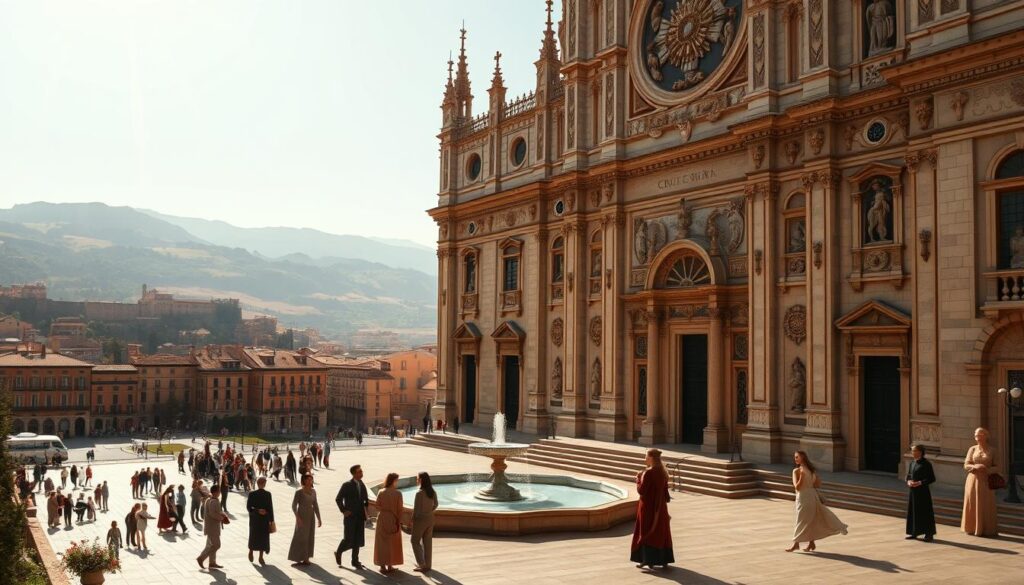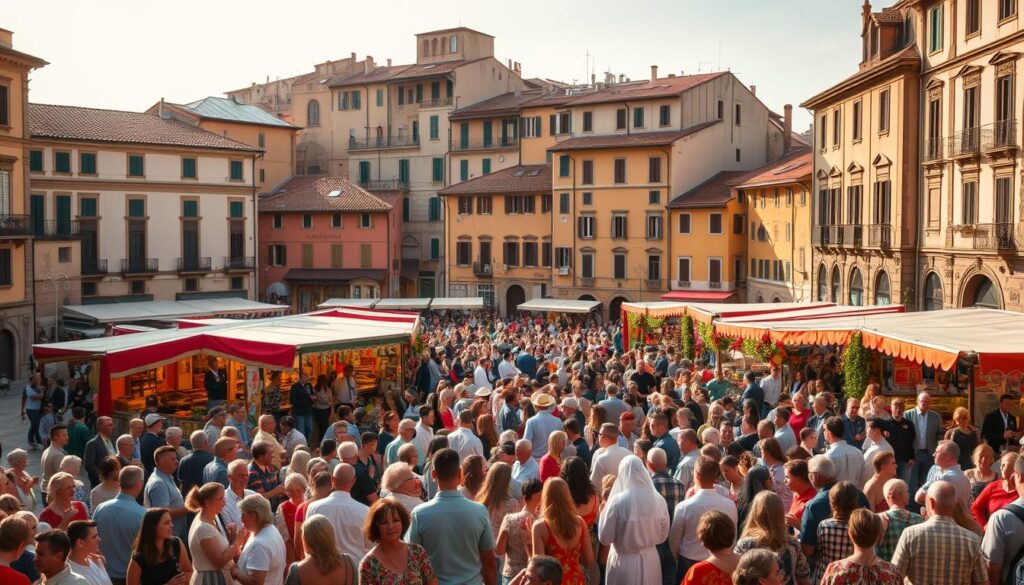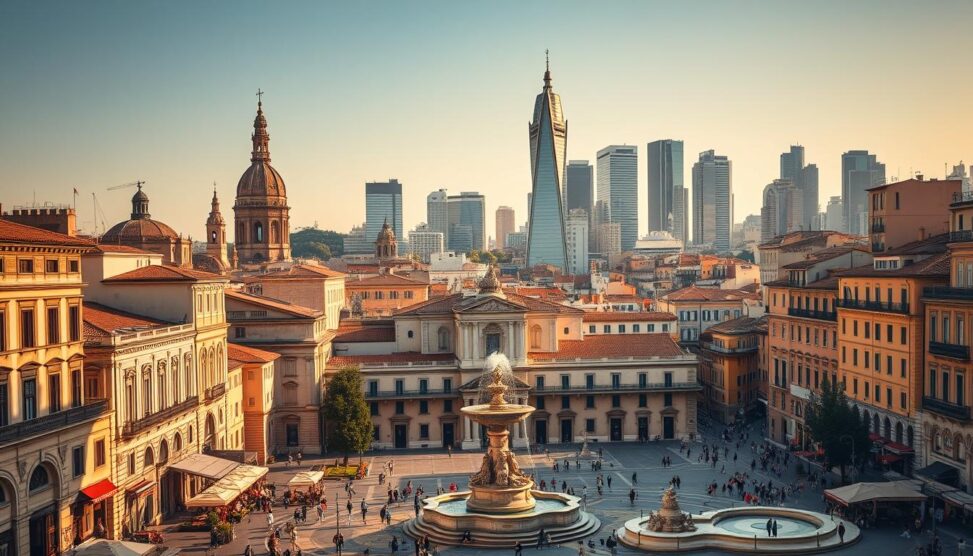Rome’s cobblestone streets showcase ancient ruins and lively piazzas. The air is filled with espresso and pasta aromas. Italian families interact vibrantly, blending tradition and modernity in their cultural tapestry.
Italy’s cultural legacy spans art, history, religion, cuisine, and fashion. It has deeply influenced Western traditions. From the Colosseum to Renaissance masterpieces, Italy’s impact is undeniable.
Contemporary Italian lifestyle is transforming the country’s cultural landscape. This evolution creates a fascinating blend of old and new.
Globalization has introduced new elements to traditional Italian customs. The 1970 legalization of divorce altered family structures. Nearly 60% of voters supported this change in 1974.
Women’s increased workforce participation has redefined gender roles in families. These shifts have contributed to a cultural transformation in modern Italy.
Family remains a cornerstone of Italian culture. Sunday lunches and holiday celebrations are cherished traditions. These gatherings emphasize strong familial bonds.
Economic factors have affected family dynamics. High youth unemployment rates lead to extended parental support. Many young adults live with parents until their mid-30s.
Italy balances tradition and modernity in its cultural products. Fashion, design, food, and wine captivate global audiences. This blend of heritage and innovation makes Italy a cultural superpower.
Understanding Traditional Italian Culture
Italy’s traditional culture is a mix of regional identities and distinct customs. Italians are proud of their local heritage. They often identify more with their city or town than the whole country.
This local patriotism, called campanilismo, stems from Italy’s historical divisions. Each region has its own unique cultural traits. These were shaped by centuries of history and tradition.
Italy’s regions have diverse dialects, cuisines, and traditions. In Alto Adige, people speak South Tyrolese German. Friuli-Venezia Giulia has the Friulian language. Sardinia uses the Sardu language.
Italian culture values family, community, and social connections. La passeggiata, the evening stroll, brings people together. Outdoor dining, or al fresco, blends food and companionship.
Family ties are strong in Italy. Many Italians live with their parents into their late twenties. Grandparents often care for children until kindergarten age.
“In Italy, they add work and life on to food and wine.” – Robin Leach
Food and drink traditions are key to Italian culture. Meals typically have three courses: pasta or rice, meat or fish, and dessert. Saying “Buon appetito” before eating is a must.
Italy’s culinary landscape is diverse. Each region has its own typical dishes. These go beyond just pasta and pizza.
Italy faces challenges of globalization and modernity. Yet, its traditional culture remains a source of pride. From vibrant festivals to timeless art, Italy’s heritage is a treasure trove.
The Flourishing Modern Italian Lifestyle
Italy has adapted to the modern world while preserving its cultural heritage. Rome, Venice, Milan, and Florence are hubs of contemporary urban life. These cities blend fast-paced lifestyles with industry and technology.
Italy maintains its traditional values, especially in rural areas. Here, life moves at a slower pace. Young people are moving to cities for jobs, changing social norms nationwide.
“Italy has the greatest number of UNESCO World Heritage Sites, totaling 60, showcasing its unparalleled cultural legacy.”
Italy’s cultural influence is seen in many international movements. From Greek and Etruscan civilizations to the Renaissance, Italy led artistic development. The High Renaissance produced legendary artists like Leonardo da Vinci and Michelangelo.
Italian opera dominates classical music. Italian cinema pioneered art films and Spaghetti Westerns. Milan’s fashion industry shapes global trends, making Italy a style icon.
Italy balances preserving heritage with embracing modern opportunities. This blend of tradition and modernity shows Italy’s adaptability. It ensures the country’s cultural legacy will thrive for future generations.
Globalization and Its Effects on Italian Culture
Globalization has greatly influenced Italy’s culture. As a top global exporter, Italy benefits from international demand for its products. Italian cuisine has even inspired dishes abroad, like Philadelphia’s cheesesteak and New Orleans’ muffuletta.
Foreign influences have raised concerns about preserving Italian heritage. Italy’s population of 58,870,762 represents diverse regional traditions. The Italian way of life is deeply rooted in community and shared values.
Italians have adapted well to globalization challenges. The country’s 12 official public holidays offer chances to celebrate cultural traditions. Typical Italian families gather weekly, often for Sunday dinner.
“Italy has a unique ability to blend the old with the new, creating a vibrant and dynamic culture that is both deeply rooted in tradition and open to the world.”
Italy must balance cultural exchange and heritage preservation. Celebrating diversity and nurturing traditions will help Italy thrive. This approach ensures success in our interconnected world.
Art and Architecture: A Blend of Eras
Italy’s italian art heritage spans ancient Roman ruins, Renaissance masterpieces, Baroque splendor, and modern Italian art movements. The Pantheon in Rome, built in 125 AD, is the best-preserved Ancient Roman monument. The Colosseum once hosted up to 80,000 spectators.

The Renaissance, from 1400 to 1600, deeply influenced Italy’s artistic landscape. Florence’s Cathedral boasts the world’s largest masonry dome, made with over 4 million bricks. Michelangelo’s David, housed in the Galleria dell’Accademia, showcases the era’s artistic genius.
The 16th century Baroque period brought heightened emotions and opulent designs to Italy. Later, the Neoclassical movement favored simplicity and classical styles. The San Carlo Theatre in Naples exemplifies this shift.
“Italy has always been a synonym for ‘good taste,’ and we have all grown up here knowing the importance of culture and beauty.”
– Brunello Cucinelli, Italian fashion designer
Early 20th century Italy saw avant-garde movements like Futurism emerge. Italian artists also explored Impressionism and Cubism, despite Paris being the artistic center. Modern Italian art movements continue to flourish today.
The MAXXI Museum in Rome showcases contemporary design influenced by Classical Roman architecture. Italy’s cities are open-air museums, blending tradition and modernity. Visitors can explore the country’s rich artistic heritage firsthand.
The Italian Language: Tradition Meets Modernity
Modern standard Italian has its roots in the Tuscan dialect. Italy’s linguistic diversity remains vibrant. Regional dialects like Sardinian, Friulian, and South Tyrolese German thrive alongside the official language.
Minority languages flourish in border areas, showcasing Italy’s rich linguistic tapestry. Younger generations embrace standard Italian more often. Yet, pride in local dialects persists, reflecting Italians’ connection to their regional identities.
Columbia University’s Italian course enrollments show varied interest levels. Elementary Italian I sections range from 6/16 to 17/16 students. Intermediate Italian courses maintain healthy participation, with some sections reaching full capacity.
“Italian is not just a language; it’s a cultural experience that connects us to our roots and opens doors to a world of art, history, and human connection.”
Italian has evolved by incorporating English loanwords and slang. This change reflects global influences while maintaining its unique character. The Italian diaspora, about 60 million people worldwide, spreads the language globally.
This ensures Italian remains a vital part of the world’s linguistic diversity. It continues to connect people to Italian culture and heritage.
Festivals and Celebrations: Then and Now
Italy is famous for its lively traditional Italian festivals and modern celebrations. These cultural events are deeply rooted in history, religion, and local customs. Many honor patron saints or commemorate historic events.
The Feast of San Gennaro in Naples is a notable saint’s celebration. The Palio di Siena horse race happens twice yearly, with 17 districts competing.

Food festivals are also popular in Italy. The Battle of Oranges in Ivrea involves a massive orange food fight. Milan’s Oh Bej! Oh Bej! festival offers unique Christmas treats for four days in December.
“Italy’s festivals are a testament to the country’s rich cultural heritage and the enduring spirit of its people.”
Many cities still hold annual festivities that unite communities. The Infiorata Festival, dating back to the 17th century, displays vibrant flower carpets. Sicily’s Easter Procession, lasting about 24 hours, is Italy’s longest-running procession.
Music festivals and cultural fairs add a modern touch to Italy’s festival scene. Tourist numbers peak during Holy Week, just before Easter Sunday. This can lead to higher hotel prices and potential overbookings.
Italy celebrates about 12 major national holidays each year. The holiday season typically starts on December 8 with Immaculate Conception. It ends on December 26 with St. Stephen’s Day.
Fashion: Icons of Tradition vs Contemporary Style
Italian fashion blends tradition and innovation. Iconic brands like Gucci, Prada, Versace, and Armani have shaped global luxury fashion. These brands champion traditional Italian style, known for impeccable craftsmanship and timeless elegance.
Traditional Italian outfits showcase intricate embroidery and luxurious fabrics. Over 30 regional styles are celebrated during cultural festivals. This rich legacy continues to inspire modern Italian fashion trends.
“Fashion is not something that exists in dresses only. Fashion is in the sky, in the street, fashion has to do with ideas, the way we live, what is happening.” – Coco Chanel
The Italian fashion industry is a major economic force. It contributes €67 billion to the economy, representing 2.2% of Italy’s GDP. The sector includes 55,000 companies and employs over 600,000 people directly and indirectly.
About 90% of Italian fashion brands focus on artisanal craftsmanship and traditional techniques. This commitment to quality is a cornerstone of the industry’s success.
Modern Italian fashion trends embrace sustainability and innovation. Surveys show 68% of consumers value sustainability in luxury fashion purchases. Many Italian brands now incorporate eco-friendly practices in response.
Technological advancements like 3D printing and AI are enhancing garment production. These innovations improve efficiency and boost creativity in design processes.
Italian fashion balances rich heritage with future-facing approaches. From Milan Fashion Week to Rome’s streets, it remains a global trendsetter. The industry celebrates traditional style while pushing contemporary design boundaries.
The Culinary Landscape: Tradition vs Innovation
Italian cuisine captivates taste buds worldwide with fresh, high-quality ingredients. It’s deeply rooted in tradition, with 85% focusing on seasonal produce. Neapolitan pizza, Ligurian pesto, and Sicilian cannoli have become global favorites.
Modern Italian gastronomy embraces innovation while respecting regional specialties. Chefs experiment with new techniques and ingredients, pushing flavor boundaries. The Slow Food movement, originating in Italy, promotes sustainable practices in over 100 countries.
Italian-American cuisine accounts for 30% of the American dining industry. The Mediterranean diet, influenced by Italian cooking, shows health benefits. Studies reveal a 15% reduction in heart disease risk among followers.
Italian artisanal products have seen a 12% export increase. This reflects growing demand for quality ingredients like Parmigiano-Reggiano and olive oil.
“Italian cuisine is not just about the food; it’s about the experience, the passion, and the love that goes into every dish.” – Chef Massimo Bottura
Fusion cuisines combine Italian techniques with other culinary traditions. They make up 5% of the global restaurant market. Handmade pasta is resurging, with 80% of Italian restaurants emphasizing this skill.
Bronze-die extruded pasta enhances sauce absorption, improving texture and flavor. Italy’s culinary landscape blends tradition with innovation. 70% of establishments experiment with fusion cuisine.
65% of professional chefs incorporate Italian cooking methods. From timeless regional specialties to modern creations, Italian gastronomy continues to inspire. It’s a testament to the enduring passion and creativity of Italy’s people.
The Role of Education in Cultural Evolution
The Italian education system shapes the nation’s cultural landscape. It balances preserving rich traditions with preparing students for the future. Education is a central pillar of Italian society, with many holding high school or junior high diplomas.
Children explore arts and culture through field trips to historic sites and museums. This helps them appreciate Italy’s cultural heritage. Most high school-age students attend public schools, which are open to all.
Public schools offer scholarships and grants. This ensures education is accessible to everyone.
“Education is the most powerful weapon which you can use to change the world.” – Nelson Mandela
The Italian education system also focuses on the future. Schools prioritize STEM fields and digital skills for an increasingly globalized world. Universities offer specialized courses and doctorate programs.
These programs equip graduates with knowledge to innovate and shape Italian culture. Education serves as a unifying force, bringing together diverse communities.
It fosters a shared sense of Italian identity. The education system balances honoring the past and embracing the future. This ensures Italy’s cultural evolution remains vibrant and dynamic.
The Future of Italian Culture: A Harmonious Blend
Italy’s cultural landscape is changing. It balances preserving traditions with embracing modernity. Efforts are underway to protect historical sites, artworks, and customs that define Italy’s identity.
Renaissance masterpieces have influenced over 90% of artistic styles. Italian regional cuisines have contributed to over 100 globally recognized dishes. The country’s cultural heritage is being celebrated through various events and initiatives.
The Collio Consortium works to preserve the area’s winemaking heritage. This showcases the unique identities of different regions in Italy.
Italy is embracing progress and innovation. “Orange wines” are gaining popularity among younger drinkers. Italian companies are increasing investments in green innovations.
The challenge is achieving cultural sustainability. Economic growth and modernization must not harm Italy’s rich cultural heritage. This requires a careful balance between adaptation and preservation.
The future of Italian culture looks promising. It will blend cherished traditions with dynamic contemporary life. Ancient crafts like Murano glassmaking will coexist with cutting-edge fashion and design.
Italy’s cultural legacy will continue to inspire the world. From the Appian Way to Italian Olympians, its influence remains strong. The country’s commitment to sustainability will preserve its cultural richness for future generations.





Leave a Reply